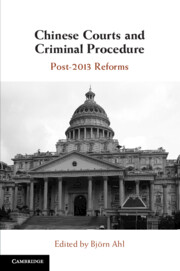Book contents
- Chinese Courts and Criminal Procedure
- Chinese Courts and Criminal Procedure
- Copyright page
- Contents
- Figures and Tables
- Contributors
- Acknowledgements
- Abbreviations
- 1 Post-2013 Reforms of the Chinese Courts and Criminal Procedure
- 2 The Meandering Path of Judicial Reform with Chinese Characteristics
- 3 Dimensions and Contradictions of Judicial Reforms in China
- 4 How the Supreme People’s Court Drafts Criminal Procedure Judicial Interpretations
- 5 Judicial (Dis)Empowerment and Centralisation Efforts
- 6 A New Model of Habeas Corpus in China? Procuratorial Necessity Examination of Pretrial Custody
- 7 Live Witness Testimony in the Chinese Criminal Courts
- 8 Blood Money and Negotiated Justice in China
- 9 Performance Evaluation in the Context of Criminal Justice Reform
- 10 From Populism to Professionalism
- Index
2 - The Meandering Path of Judicial Reform with Chinese Characteristics
Published online by Cambridge University Press: 25 June 2021
- Chinese Courts and Criminal Procedure
- Chinese Courts and Criminal Procedure
- Copyright page
- Contents
- Figures and Tables
- Contributors
- Acknowledgements
- Abbreviations
- 1 Post-2013 Reforms of the Chinese Courts and Criminal Procedure
- 2 The Meandering Path of Judicial Reform with Chinese Characteristics
- 3 Dimensions and Contradictions of Judicial Reforms in China
- 4 How the Supreme People’s Court Drafts Criminal Procedure Judicial Interpretations
- 5 Judicial (Dis)Empowerment and Centralisation Efforts
- 6 A New Model of Habeas Corpus in China? Procuratorial Necessity Examination of Pretrial Custody
- 7 Live Witness Testimony in the Chinese Criminal Courts
- 8 Blood Money and Negotiated Justice in China
- 9 Performance Evaluation in the Context of Criminal Justice Reform
- 10 From Populism to Professionalism
- Index
Summary
The chapter begins by outlining three stages of China’s judicial reform journey. The first stage, marked by the Western-oriented reforms launched in the late 1970s, featured judicial activism within uncertain boundaries. The second stage is often depicted as constituting a U-turn. This relatively brief stage was characterised by the revival of the mediation system and redistribution of power within the political–legal system. Finally, the third stage comprises the grand changes introduced since the 4th Plenum of the 18th Party Congress. The chapter then turns to the major reform measures introduced in the current round of reforms and uses empirical data to evaluate the extent to which they constitute a deviation from the previous reform path. Although the greater judicial transparency, personnel reforms, soft-centralisation of the judicial organs and ongoing supervision reform seen during this round have effected a fundamental overhaul of judicial power, they remain influenced by deeply embedded political constraints. The final section of the chapter summarises the Chinese characteristics of the pursuit of rule of law in a one-party state, including the ongoing populist turn, selective adoption of Western experiences, development of a distinct dispute resolution system, cycles of decentralisation and centralisation, and persistent party leadership.
- Type
- Chapter
- Information
- Chinese Courts and Criminal ProcedurePost-2013 Reforms, pp. 29 - 58Publisher: Cambridge University PressPrint publication year: 2021
- 6
- Cited by

